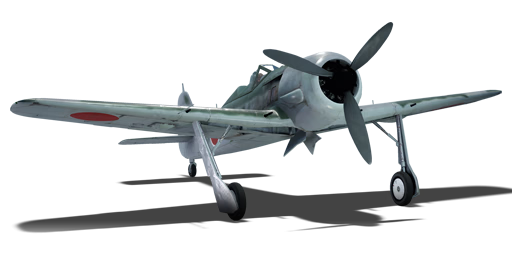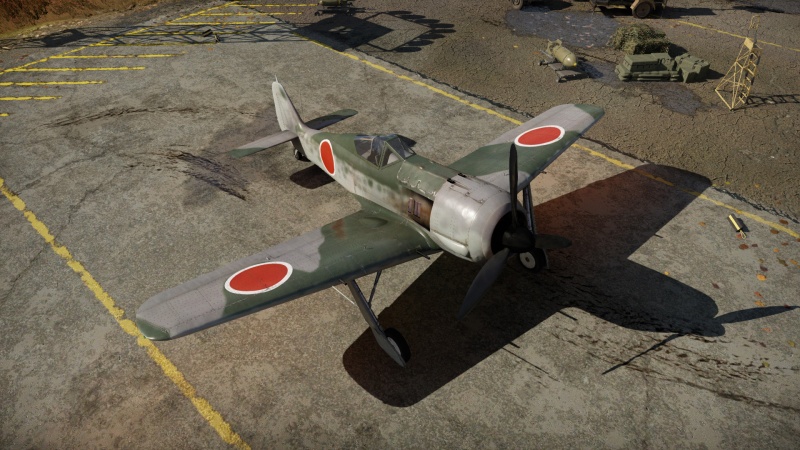Fw 190 A-5 (Japan)
| This page is about the premium Japanese fighter Fw 190 A-5 (Japan). For the German version, see Fw 190 A-5. For other versions, see Fw 190 (Family). |
Contents
Description
The ▅Fw 190 A-5 is a premium rank IV Japanese fighter with a battle rating of 5.3 (AB) and 4.7 (RB/SB). It has been in the game since the start of the Open Beta Test prior to Update 1.27 as the Fw 190 A-5/U3, but was renamed to Fw 190 A-5 in Update 1.35.
Rocking four 20 mm cannons, an armoured radial engine and armoured fuel tanks, this aircraft is far but shy in the giving and taking role. Anything at 12 o'clock is soon to be smithereens. The wing root mounted cannons should be additionally placed on a separate key for head-on attacks. The outer-wing guns would only miss on distances of 800-1,000 m (~0.7 miles). This also helps for tricky shots, as the second pair of 20 mm guns only have 90 shots each, instead of the whopping 250 of the inner ones. But make sure to bring hell loose ones the optimal firing solution is reached.
General info
Flight performance
| Characteristics | Max Speed (km/h at 5,800 m) |
Max altitude (meters) |
Turn time (seconds) |
Rate of climb (meters/second) |
Take-off run (meters) | |||
|---|---|---|---|---|---|---|---|---|
| AB | RB | AB | RB | AB | RB | |||
| Stock | 623 | 603 | 12000 | 23.2 | 24.1 | 10.8 | 10.8 | 420 |
| Upgraded | 675 | 648 | 20.8 | 22.0 | 18.2 | 14.1 | ||
Details
| Features | ||||
|---|---|---|---|---|
| Combat flaps | Take-off flaps | Landing flaps | Air brakes | Arrestor gear |
| X | ✓ | ✓ | X | X |
| Limits | ||||||
|---|---|---|---|---|---|---|
| Wings (km/h) | Gear (km/h) | Flaps (km/h) | Max Static G | |||
| Combat | Take-off | Landing | + | - | ||
| 0 | 310 | 900 | 700 | 310 | ~13 | ~6 |
| Optimal velocities (km/h) | |||
|---|---|---|---|
| Ailerons | Rudder | Elevators | Radiator |
| < 420 | < 300 | < 550 | > 320 |
| Compressor (RB/SB) | ||
|---|---|---|
| Setting 1 | ||
| Optimal altitude | 100% Engine power | WEP Engine power |
| 700 m | 1,498 hp | 1,685 hp |
| Setting 2 | ||
| Optimal altitude | 100% Engine power | WEP Engine power |
| 5,300 m | 1,301 hp | 1,464 hp |
Survivability and armour
- 57 mm Bulletproof glass in front of the cockpit
- 3-5 mm Steel plates in front of oil cooling system
- 6 mm Steel plate under the radial engine
- 12 mm Steel plate in pilot's headrest, and an 8 + 6 mm steel plates behind the pilot
- 8 mm Steel plate under the cockpit
- 5 mm Steel plate behind the fuel tank
Modifications and economy
Armaments
Offensive armament
The Fw 190 A-5 (Japan) is armed with:
- 2 x 20 mm MG 151/20 cannons, wing-mounted (250 rpg = 500 total)
- 2 x 20 mm MG FF/M cannons, wing-mounted (90 rpg = 180 total)
- 2 x 7.92 mm MG 17 machine guns, nose-mounted (900 rpg = 1,800 total)
Usage in battles
The Fw 190A-5/U2, as all the planes in this line, are some of the best Boom & Zoomers in the game and should be flown exclusively in this style. The performance at high speeds is excellent, as is their dive and zoom characteristics. Do not ever engage in a turn fight as this will most likely end badly, instead only fight in the vertical. Try to have an altitude, or speed advantage over the opponents (by climbing to the side at the start of the battle and then enter the highest dog fight). But the Fw 190 can still win fights when in a lower energy state than the foe.
In the defensive, best option is to just dive away from planes, such as Spitfires and La-5s, but it needs to be at a decent altitude to gain top speed, so do not be too quick to dive after an enemy if they are flying at a lower altitude. Unless the Fw 190 is higher than everybody else, or alone. Just be sure then to have the time to regain the lost altitude.
In a dive, the 190 can, due to its short wings, pull quite some stunts to either lose the hunter or even make him lose his own wings! This is favourable strategy against La-5s, Yaks & Spitfires who have due to their low wing-loading (and partly wooden wings for the Russians), less resistance against high G manoeuvres. Again be sure to regain energy by a zoom-climb. Just look out while doing so, many pilots die as they do not notice a second enemy aircraft approaching. German proverb:"Wenn Zwei sich streiten, freut sich der Dritte." ~ "When two quarrel, the third will reap the success." Of course, this could also be highlighting an opportunity to take in the skies.
Manual Engine Control
| MEC elements | ||||||
|---|---|---|---|---|---|---|
| Mixer | Pitch | Radiator | Supercharger | Turbocharger | ||
| Oil | Water | Type | ||||
| Not controllable | Controllable Auto control available |
Not controllable Not auto controlled |
Controllable Not auto controlled |
Combined | Not controllable 2 gears |
Not controllable |
Pros and cons
Pros:
- Best roll rate
- Good climb rate
- Performs very well in dives
- Good at Boom & Zoom
- Excellent firepower
Cons:
- Engine overheats fast
- Not that fast in level flight
- Turns poorly
- Not much defensive possibilities (only dive and scissors)
History
In 1943, the Imperial Japanese Navy Air Service imported one Fw 190 A-5 from Germany,[1] which was delivered via submarine. The Fw 190 A-5 model was tested at the Fussa airfield, the Imperial Japanese Army's central testing facility for aircraft. The plane was flown by Lieutenant Commander Aramaki Yoshitsugu, who found the Fw 190 cockpit size just right as opposed to the tightness of the Bf 109 or the spaciousness of a P-40.[2]
The Fw 190 A-5 was also tested alongside Japanese aircraft and prototypes, including the prototypes that would be the Ki-84 and Ki-100. During these, it was deemed that the Fw 190 performance was similar to that of the Ki-84. Overall Japanese impression of the Fw 190 A-5 was positive, with better firepower than most other Japanese planes, reliable electric systems, fine craftsmanship, and a reliable engine.[2]
The Allies predicted that the Japanese would use the Fw 190 as a fighter aircraft and gave the Fw 190 the nickname "Fred" in 1942.[1][3] However, it is not known if the Japanese ever used the Fw 190 in combat purposes against the Allies. The last known reported the presence of the Fw 190 A-5 was it being loaned to a reconnaissance unit, with its ultimate fate unknown but presumably lost.[2]
In-game description
The Focke-Wulf Fw 190 Wuerger (Shrike) was a single-seat, single-engine monoplane fighter used by the Luftwaffe in WWII. One of the best fighters of the time, it was widely used during the Second World War. A total of over 20,000 were produced, including some 6,000 fighter-bomber variants. The 190 remained in production from 1941 until the end of the war, going through multiple redesigns. The Fw 190 made a name for itself as a true Luftwaffe workhorse and was used in a wide variety of roles, including a high-altitude interceptor (especially the Fw 190 D), escort fighter, fighter-bomber and night fighter.
1942 flight tests of the Fw 190 A-3 proved that the installation of additional equipment could shift the plane's center of gravity. To address the issue, the aircraft had to be lengthened. First examples, designated Fw 190 A-5, saw combat in November 1942. Other modifications were minor and included improved oxygen equipment and a new artificial horizon. All production aircraft were also equipped with the FuG 25a IFF set. The armament remained unchanged.
Media
- Skins
- Videos
See also
- Related development
- Aircraft of comparable role, configuration and era
External links
Citations
Bibliography
- Arawasi. "Japanese Focke-Wulf Fw 190." WildEagles. N.p., 22 Jan. 2014. Web. 01 Feb. 2018. Website.
- Dyer, Edwin M. Japanese Secret Projects: Experimental Aircraft of the IJA and IJN, 1939-1945. Midland, 2009.
- Hanson, David. "Focke-Wulf Fw 190A5 (Fred)." Dave's Warbirds. N.p., n.d. Web. 01 Feb. 2018. Website.
| Focke-Wulf Aircraft Corporation (Focke-Wulf Flugzeugbau Aktiengesellschaft) | |
|---|---|
| Fighters | Fw 190 A-1 · Fw 190 A-4 · Fw 190 A-5 · Fw 190 A-5/U2 · Fw 190 A-5/U12 · Fw 190 A-5/U14 · Fw 190 A-8 |
| Fw 190 C | |
| Fw 190 D-9 · Fw 190 D-12 · Fw 190 D-13 | |
| Fw 190 F-8 | |
| Ta 152 C-3* · Ta 152 H-1* · Ta 154 A-1* | |
| Bombers | Fw 189 A-1 · Fw 200 C-1 |
| Export | ▅Fw 190 A-5 |
| Captured | ▃Fw 190 A-8 · ▂Fw 190 D-9 |
| * In 1944, the Germany Air Ministry changed new fighter aircraft designation to that of the chief designer. Kurt Tank was the chief designer at Focke-Wulf and later aircraft he designed were given the prefix of Ta. | |
| Japan fighters | |
|---|---|
| Navy | |
| Carrier-based fighter | |
| A5M | A5M4 · Hagiri's A5M4 |
| A6M | A6M2 mod. 11 · A6M2 · A6M3 · A6M3 mod. 22 · A6M3 mod. 22Ko · A6M5 · A6M5 Ko · A6M5 otsu · A6M5 Hei · A6M6c |
| A7He | A7He1* |
| A7M | A7M1 (NK9H) · A7M2 |
| Land-based Fighter | |
| J2M | J2M2 · J2M3 · J2M4 Kai · J2M5 · J2M5 (30 mm) |
| J6K | J6K1 |
| J7W | J7W1 |
| N1K-J | N1K1-Ja · N1K2-J · N1K2-Ja |
| Fighter seaplane | |
| N1K | N1K1 |
| A6M-N | A6M2-N |
| Army | |
| Ki-10 | Ki-10-I · Ki-10-I C · Ki-10-II · Ki-10-II C |
| Ki-27 | Ki-27 otsu · Ki-27 otsu Tachiarai |
| Ki-43 | Ki-43-I · Ki-43-II · Ki-43-III otsu |
| Ki-44 | Ki-44-I · Ki-44-I 34 · Ki-44-II otsu · Ki-44-II hei |
| Ki-61 | Ki-61-I ko · Ki-61-I otsu · Ki-61-I hei · Tada's Ki-61-I hei · Ki-61-I tei · Ki-61-II Otsu Kai |
| Ki-84 | Ki-84 ko · Ki-84 otsu · Ki-84 hei |
| Ki-87 | Ki-87 |
| Ki-94 | Ki-94-II |
| Ki-100 | Ki-100 · Ki-100-II |
| Other countries | ▅F4U-1A · ▅P-51C-11-NT · ▅Bf 109 E-7 · ▅Fw 190 A-5 |
| *Imported designation of the He 112 (A6M was in development - A7M would take A7 designation after the cancelation of the A7He) | |
| Japan premium aircraft | |
|---|---|
| Fighters | Hagiri's A5M4 · A7He1 · Ki-27 otsu Tachiarai |
| Ki-44-II otsu · ▅Bf 109 E-7 · ▅F4U-1A · Ki-100-II · Ki-44-I 34 | |
| ▅Fw 190 A-5 · A7M1 (NK9H) · Tada's Ki-61-I hei · ▅P-51C-11-NT | |
| J2M4 Kai · A6M5 Ko · A6M6c · J2M5 · Ki-87 · J6K1 | |
| Twin-engine fighters | Ki-96 |
| Jet fighters | F-86F-40 JASDF▅ · T-2 Early · F-4EJ ADTW |
| Strike aircraft | ▄AV-8S |
| Bombers | Ki-21-I hei · Ki-48-II otsu · H8K3 · B7A2 (Homare 23) · ▅B-17E |





